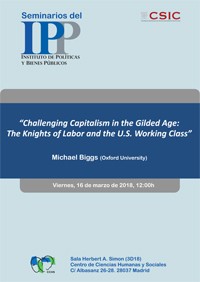Seminario IPP: "Challenging Capitalism in the Gilded Age: The Knights of Labor and the U.S. Working Class"
Por Michael Biggs (Oxford University)
Sala Herbert A. Simon 3D
Organiza: Francisco Javier Moreno Fuentes (IPP, CCHS-CSIC)
Resumen de la presentación: The Knights of Labor, the world’s largest working-class organization in the nineteenth century, remains enigmatic. Scholars have parsed the discourse of its leaders and traced its activity in major cities, but we still lack a portrait of its membership. This paper combines Garlock’s pioneering databank of Local Assemblies with microdata from the 1880 Census. It analyzes the distribution of Local Assemblies across 2,386 counties, from 1881 to 1886. Although most of the Order’s members came from the industrial metropolises of the East and Midwest, the rate of recruitment was highest in the small towns of predominantly rural states like Wyoming and Texas. This pattern is explained by concentrations of railroad workers and miners. There is also evidence that the Knights of Labor were helped by rural allies, namely small cotton farmers outside the black belt. The Order was open to unskilled laborers—unlike craft unions—but analysis reveals that in practice it was more successful where skilled workers were prevalent.



